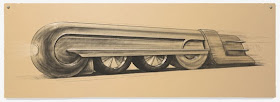About one week ago, I posted a clip from subchat showing a front window view of the new Flushing Line # 7 extension to 34th Street. At 42nd Street and 8th Avenue, the line crosses at right angles the lower level of the 42nd Street - 8 th Avenue subway station. This lower level station is unusual in that it consists of one track and one side platform under a four track busy station. Please find below a map of the Eight Avenue Line from 59th Street to West 4th Street between 1932 and 2006 and a map of the same line from West 4th Street to High Street Brooklyn between the same dates. Both maps were based on data from B. Linder and the track drawing is by J. Elitz.
Source: Linder, B. & Erlitz, J, "Eight Avenue Subway Track Plans" in New York Division, Electric Railroaders' Association, The Bulletin, Vol. 50, No. 1, January, 2007, pp.2-3.
Notice the detail of the 42nd Street station on Page 2. The platforms on the upper level are staggered with the southbound platform is more south than the northbound platform. Notice that the lower level track was taken out of service on 10/19/1999 with switches removed in 2002 or 2003. This means that the station was abandoned for a long time. The movie that was shot in the lower level was called "Ghost" and was made in 1980. The shot below is that of Vincent Schiavelli who I believe passed away. He was not only an actor but he had, I believe a cooking show on Public TV.
Even though the lower station may have been "cut off" by the new IRT Flushing Line extension, I believe that there may have been enough room on the platform to display older model subway cars or even a trolley car. I am not sure that a streetcar would have enough space down there. Perhaps the lead tracks were in miserable condition and they had to be isolated and cut off.


















































